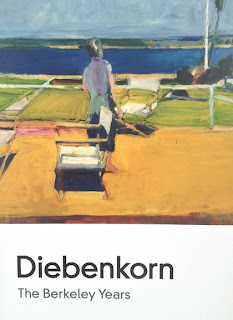Diebenkorn has long been among my favorite abstract painters. There's something about his work that resonates with me, but I realize I knew very little about his life or about the long arc of his career before seeing this show, which helped to educate me a little. For example, I was almost completely unaware of the figurative work he did during the middle of the period covered here. Judging from the paintings included, Diebenkorn focused briefly on figurative subjects mostly between about 1956 and 1958. These works are sandwiched between earlier, purely abstract works characterized by flat patches of color (often in pinks, ochre, and other fleshy tones) and later abstract work with a greater emphasis on line. It's the earlier abstract work (roughly between 1953 to 1955) that I enjoy most. It was a real pleasure to stand in a large room surrounded by about 15 large works from the early period. Berkeley No. 3 (1953, below) is typical.
The figurative paintings seem less successful to me. It may simply be a matter of taste, but they don't speak to me the way the abstract paintings do. That said, it was interesting to see Diebenkorn's foray into an area of painting that was quite unfashionable at the time—a time when American abstraction was at the center of the Western art world. Perhaps it was conscious rebellion. Perhaps it felt too easy to paint the abstractions. I don't mean to suggest that abstraction is in any way easier than figurative art. In fact, I believe quite the contrary. The figurative artist at least has his subject in front of him as a point of reference. Painting in the abstract requires the subject itself to be conjured up out of thin air, although much that passes for abstract art is, in fact, referential. I mean simply that I think artists sometimes become suspicious of their own motives and the value of their work when they produce a great deal quickly, and Diebenkorn was certainly prolific during his early years in Berkeley. Perhaps he felt the need to step away from what he was doing so successfully at the time. It was during his first couple of years in Berkeley that he appears to have quite suddenly attracted a great deal of attention from the media. Coffee (1959) is typical of the figurative paintings. It's among those I like best, but the figurative work seems somehow less authentic, less the result of committed interest, the color less inspired—certainly less sensual. Still, it was very useful to see the many works from this period included in the show.
After the flirtation with making large figurative paintings, the return to abstraction is marked by a somewhat more rigid, geometrical quality. Line becomes a much more central element. The paintings are almost cartographic. They look like aerial photographs of agricultural land broken up by the occasional line of trees along a river. They are less fluid than the earlier work. The last third of the show is mostly paintings in this more linear style, but interspersed throughout the show are figure drawings that Diebenkorn continued to make regardless of where his painting was going. Eventually the growing emphasis on line blossomed into the even more linear, straight-edged paintings with Ocean Park titles such as the one pictured here, which is in the De Young's permanent collection--Ocean Park 119 (1979).
I've never before seen so many of Diebenkorn's works collected together. It's not often that I immediately want to go back again to see a show I've just walked through, but I hope to visit the Diebenkorn show once more before it leaves the DeYoung. Well worth a visit—or two. There is much to see here. The show runs through September 29.










No comments:
Post a Comment